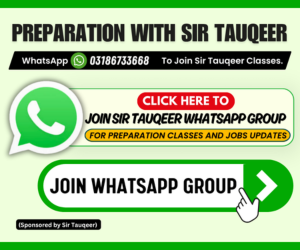-
 Home
Home
-
 News
News
Latest Educational News Stories
Daily update of all national, international news, picture stories, college / university announcements and educational events.
-
 Colleges
Colleges
Pakistan's Largest Database of Colleges and Universities
Explore Largest Directory of Private and Govt. Colleges, Universities and find best institute for your future Education.
-
 Courses
Courses
-
 Admission
Admission
-
 Lectures
Lectures
-
 Online Test
Online Test
Short Question
- 9th Class Physics Short Questions
- 9th Class Chemistry Short Questions
- 9th Class Math Short Questions
- 9th Class Biology Short Questions
- 9th Class Computer Short Questions
- 9th Class English Short Questions
- 10th Class Physics Short Question
- 10th Class Chemistry Short Question
- 10th Class Math Short Question
- 10th Class Biology Short Question
- 10th Class Computer Short Question
- 10th Class English Short Question
-
 Past Papers
Past Papers
-
 Date Sheets
Date Sheets
-
 Results
Results
Exam Results 2024
Check online Results 2024 Matric Inter BA BSc B.Com MA MSc M.Com CSS PCS MCAT ECAT of all educational boards and universities in Pakistan
-
 Study Abroad
Study Abroad
Study Abroad Programs and Opportunities for Pakistani Students
Explore free study abroad search to find programs, consultants, events to study in USA, UK, Australia, China, Malaysia and many others.
-
 Jobs
Jobs
-
 Tutors
Tutors
-
 More
More
-
 Apps
Apps

Introduction to 11th Class Physics – Circular and Rotational Motion
11th Class Physics Chapter 3: Circular and Rotational Motion is a key topic in the FSc Part 1 Physics book that explains how objects move in circular paths and how rotational motion differs from linear motion. Understanding this chapter is essential for building a strong base in mechanics. Whether you are studying from the 11th class Physics book 2025 or watching class 11th Physics video lectures Circular and Rotational Motion, this topic will help you grasp one of the most fascinating areas of physics — motion that involves rotation and revolution.
In class 11th Physics, students are introduced to new types of motion where the direction of movement constantly changes. Circular and rotational motion are found everywhere — from the movement of the planets around the sun to the spinning of a wheel. Learning these concepts in Physics Chapter Circular and Rotational Motion 11th class not only strengthens conceptual understanding but also enhances analytical and problem-solving skills needed for board exams and competitive tests.
Understanding Circular and Rotational Motion in Class 11 Physics
In FSc Part 1, Physics Chapter 3, students explore both circular motion (motion of an object along a circular path) and rotational motion (motion of a body about its own axis). The Physics federal book class 11 explains these concepts using real-world examples and mathematical derivations that help students visualize how forces act during rotation.
Circular motion occurs when an object moves in a circle with constant speed but changing direction. Important quantities such as angular velocity, angular acceleration, and centripetal force are introduced in this section of the 11th class Physics book. Students also learn about centripetal acceleration and centripetal force, which keep an object moving along a circular path.
On the other hand, rotational motion deals with how rigid bodies rotate about a fixed axis. The 11 class Physics book introduces terms like moment of inertia, torque, and angular momentum — all of which describe the rotational dynamics of objects. These topics bridge the gap between theoretical concepts and practical applications in engineering, robotics, and astronomy.
Through this chapter, students develop a deep understanding of how linear and rotational quantities are related and how energy and forces behave in rotational systems.
Learn with 11th Class Physics Video Lectures
Students who want extra help understanding these topics can watch 11th class Physics video lectures Circular and Rotational Motion or download class 11 Physics video lectures free for revision. These online lessons follow the 11th class Physics book 2025 and cover every topic in detail, making it easier for students to grasp formulas, equations, and problem-solving methods.
The 11th Class Physics Chapter Circular and Rotational Motion Video Lectures include visual demonstrations of rotational dynamics, examples of circular motion, and explanations of how torque and angular momentum affect rotating bodies. These class 11th Physics video lectures are ideal for exam preparation and help students understand even the most complex concepts in a simple and interactive way.
Conclusion
Class 11th Physics Chapter 3 – Circular and Rotational Motion is a vital part of FSc Part 1 Physics, providing insight into one of the most practical areas of mechanics. By studying this topic from the Physics book 11 class and using 11th class Physics video lectures, students can master the principles of motion, torque, and rotational dynamics. Whether you’re preparing for board exams or aiming for higher studies in engineering and physics, this chapter will strengthen your conceptual foundation and analytical thinking.
11th Class Physics Chapter 3: Circular and Rotational Motion is a key topic in the FSc Part 1 Physics book that explains how objects move in circular paths and how rotational motion differs from linear motion. Understanding this chapter is essential for building a strong base in mechanics. Whether you are studying from the 11th class Physics book 2025 or watching class 11th Physics video lectures Circular and Rotational Motion, this topic will help you grasp one of the most fascinating areas of physics — motion that involves rotation and revolution.
In class 11th Physics, students are introduced to new types of motion where the direction of movement constantly changes. Circular and rotational motion are found everywhere — from the movement of the planets around the sun to the spinning of a wheel. Learning these concepts in Physics Chapter Circular and Rotational Motion 11th class not only strengthens conceptual understanding but also enhances analytical and problem-solving skills needed for board exams and competitive tests.
Understanding Circular and Rotational Motion in Class 11 Physics
In FSc Part 1, Physics Chapter 3, students explore both circular motion (motion of an object along a circular path) and rotational motion (motion of a body about its own axis). The Physics federal book class 11 explains these concepts using real-world examples and mathematical derivations that help students visualize how forces act during rotation.
Circular motion occurs when an object moves in a circle with constant speed but changing direction. Important quantities such as angular velocity, angular acceleration, and centripetal force are introduced in this section of the 11th class Physics book. Students also learn about centripetal acceleration and centripetal force, which keep an object moving along a circular path.
On the other hand, rotational motion deals with how rigid bodies rotate about a fixed axis. The 11 class Physics book introduces terms like moment of inertia, torque, and angular momentum — all of which describe the rotational dynamics of objects. These topics bridge the gap between theoretical concepts and practical applications in engineering, robotics, and astronomy.
Through this chapter, students develop a deep understanding of how linear and rotational quantities are related and how energy and forces behave in rotational systems.
Learn with 11th Class Physics Video Lectures
Students who want extra help understanding these topics can watch 11th class Physics video lectures Circular and Rotational Motion or download class 11 Physics video lectures free for revision. These online lessons follow the 11th class Physics book 2025 and cover every topic in detail, making it easier for students to grasp formulas, equations, and problem-solving methods.
The 11th Class Physics Chapter Circular and Rotational Motion Video Lectures include visual demonstrations of rotational dynamics, examples of circular motion, and explanations of how torque and angular momentum affect rotating bodies. These class 11th Physics video lectures are ideal for exam preparation and help students understand even the most complex concepts in a simple and interactive way.
Conclusion
Class 11th Physics Chapter 3 – Circular and Rotational Motion is a vital part of FSc Part 1 Physics, providing insight into one of the most practical areas of mechanics. By studying this topic from the Physics book 11 class and using 11th class Physics video lectures, students can master the principles of motion, torque, and rotational dynamics. Whether you’re preparing for board exams or aiming for higher studies in engineering and physics, this chapter will strengthen your conceptual foundation and analytical thinking.












